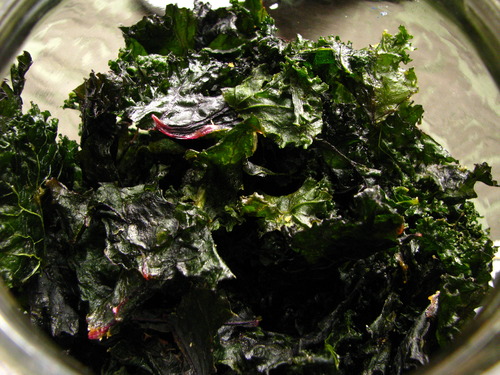kale
 kale chips
kale chips
Photo by bee wolf ray and licensed under the Creative Commons Attribution 2.0 Generic license.
Description
Kale is a hearty, leafy, and somewhat bitter-tasting green that ranges in color (purple to green) and texture (curly to flat). It's used in soups, salads, sautes, and smoothies. And it's incredibly nutritious, particularly when raw, steamed, or lightly cooked.
While kale can be eaten raw or cooked, the stem and leaf spine is very tough and almost always removed, either discarded or finely sliced and cooked separately.
Kale is a headless member of the cabbage family (meaning its central leaves do no form a head), and its relatives include broccoli, collard greens, brussel sprouts, and kai-lan.
Also Known As
borecole
Nutritional Info
Kale is notably high in fiber, minerals, and vitamins A, C, and K, as well as calcium and flavonoids with antioxidant and anti-inflammatory benefits. According to Wikipedia, indole-3-carbinol and sulforaphane give it anti-cancer properties (although boiling may significantly reduce its potency), while bile acid sequestrants in it have been shown to lower cholesterol, even more so when steamed.
Kale is good stuff, although according to WebMD it also contains oxalates, which inhibit calcium absorption. Avoid pairing kale with dairy and other calcium-rich foods.
Selecting
Choose bunches with firm leaves and hearty stems.
Storage
Store dry in a paper towel. Refrigerate (or even freeze) to avoid wilting. Use within a few days to avoid bitterness.
Kale Recipes
-
 easy mapo with kale (faux-po)by joanie
easy mapo with kale (faux-po)by joanie -
 simple kale saladby joanie
simple kale saladby joanie -
 creamed kaleby joanie
creamed kaleby joanie -
 sausage, potato & kale soupby joanie
sausage, potato & kale soupby joanie -
 Grilled kale with onions and red pepperby elipawse
Grilled kale with onions and red pepperby elipawse -
 kale chipsby joanie
kale chipsby joanie -
 raw kale and cabbageby joanie
raw kale and cabbageby joanie -
 kale pineapple smoothieby joanie
kale pineapple smoothieby joanie -
 crispy kale and coconut farroby joanie
crispy kale and coconut farroby joanie -
 Kale with Bacon and Red Onionby Barney
Kale with Bacon and Red Onionby Barney -
 Kale with Garlic & Toasted Pumpkin Seedsby Tara
Kale with Garlic & Toasted Pumpkin Seedsby Tara -
 Kale with Bacon and Onionby car2ngrl
Kale with Bacon and Onionby car2ngrl -
 Lemony Spicy Kaleby alchemisty
Lemony Spicy Kaleby alchemisty -
 Crunchy Kale and Coconut Bowlby Lyn
Crunchy Kale and Coconut Bowlby Lyn -
 beanless minestrone soupby rosemarypepper
beanless minestrone soupby rosemarypepper -
 Sweet Potato with Kale and Ricottaby belinda
Sweet Potato with Kale and Ricottaby belinda -
 Kale Chipsby Sarah Xiong
Kale Chipsby Sarah Xiong -
 Pasta shellsby Sarah Xiong
Pasta shellsby Sarah Xiong -
 Garlic-Roasted Crispy Kaleby alchemisty
Garlic-Roasted Crispy Kaleby alchemisty -
 Kevin's green smoothieby joanie
Kevin's green smoothieby joanie -
 Capellini with Pistachio-Mint-Kale Pesto and Green Beansby alchemisty
Capellini with Pistachio-Mint-Kale Pesto and Green Beansby alchemisty -
 Quinoa and Kale Saladby Sarah Xiong
Quinoa and Kale Saladby Sarah Xiong -
 Take Me Away Green Smoothieby libbylouer
Take Me Away Green Smoothieby libbylouer -
 Kale Butternut Squash Turkey Soupby TasteAndSee
Kale Butternut Squash Turkey Soupby TasteAndSee -
 Kale Orange Cranberry Saladby TasteAndSee
Kale Orange Cranberry Saladby TasteAndSee -
 Healthy Kale Egg Breakfast Cupsby TasteAndSee
Healthy Kale Egg Breakfast Cupsby TasteAndSee -
 Copycat Olive Garden Zuppa Toscana Soupby thebloggerpearl
Copycat Olive Garden Zuppa Toscana Soupby thebloggerpearl -
 Copycat Olive Garden Zuppa Toscana Soup 2by thebloggerpearl
Copycat Olive Garden Zuppa Toscana Soup 2by thebloggerpearl -
 Chicken Kale Energy Bowl with Italian Sun-Dried Tomato Sauceby TasteAndSee
Chicken Kale Energy Bowl with Italian Sun-Dried Tomato Sauceby TasteAndSee -
 Pan-Fried Sea Bassby MyNutriCounter
Pan-Fried Sea Bassby MyNutriCounter






























